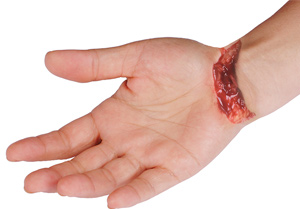Tendon and Nerve Lacerations

A laceration is a tear or ragged opening in the skin usually caused by an injury or trauma. A laceration may be either a partial laceration or a complete laceration. Tendons connect muscles to bones and allow coordinated movement of the joints. A deep cut or laceration on the palm side of the hand can damage the flexor tendons, which control movement in your hand. Since the nerves of the hands are located very close to the tendons, a laceration may damage them as well, causing numbness in your fingers.
Causes
Tendon and nerve lacerations may be caused by blunt trauma such as a sudden blow or a fall or by sharp objects such as a knife or broken glass.
Symptoms
The symptoms of a tendon laceration include pain, tenderness, and inability to bend the joints of your finger. Lacerated nerves often cause pain and numbness in your fingers.
Diagnosis
The diagnosis of tendon and nerve lacerations is made on the basis of your history and physical examination. An X-ray may be taken to rule out any fractures. If the nerves are lacerated your doctor may order an electromyography (EMG) or nerve conduction velocity (NCV), an electrical conduction test to determine the extent of damage to the nerve. Sometimes, an MRI Neurography or CT scan also may be recommended.
Treatment
The treatment for tendon laceration includes cleansing the wound, removal of dead tissue and dressing or splinting of the wound to prevent infection. If required pain medications or antibiotics may be prescribed to reduce pain and inflammation and prevent infection. Physical therapy is usually prescribed to regain range of motion, strength and function.
If a tendon is completely lacerated, surgery to sew the ends of the tendon back together may be necessary. After surgery, a dressing or splint is applied to protect the repair.
Other Hand & Wrist List
- Trigger Finger
- Scaphoid Fracture
- Dupuytren’s Contracture
- Arthritis of the Wrist
- Flexor Tendon Injuries
- Wrist Pain
- Ganglion (Cyst) of the Wrist
- Wrist Tumours
- Arthritis of the Hand (Digit Arthritis)
- Wrist Fracture
- Hand Fractures
- Ligament Injuries
- Tendinitis
- Normal Hand Anatomy
- Carpal Tunnel Syndrome
- Arthritis of the Thumb

 Menu
Menu






